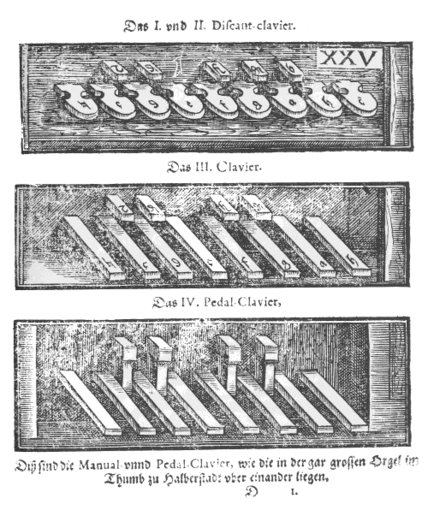52,877,512
By asking this question, I do not mean that in C Major - the most frequently used key. I wonder why the notes on the white keys of the piano are structured with respect to the key of C Major, A Major instead?
In short, the important role of C major as the tone with no signs of alteration - the result of historical practices that have formed and developed in the framework of medieval vocal tradition, before the invention and standardization of the modern layout of keys, that is, before the fixed major and minor scales and tonalities.
The keys are arranged just so, not because the modern point of view this is the most simple and effective layout - their position is based on the pre-classical western music theory in the early periods of development has changed several times, becoming more comfortable for the performer.
To give a complete answer to this question, we need to develop a theme of medieval music theory.

Medieval hexachord and Gvidonova arm - not your grandmother's tales h4> Gvidonova hand was created Guido d'Arezzo (Guido d'Arezzo) (approx. 991 - 1033), a monk of the Benedictine Order, long before the advent of modern seminotnoy sequence . She helped singers (singing Gregorian chant) to calculate intervals and determine the height of sounds. It is the foundation of Western music theory for hundreds of years, but had forgotten about it around the beginning of the seventeenth century.
We are accustomed to a system in which the music is associated with a major or minor scale semitonalnoy type, and when we say "salt" or "D flat", we mean the pitch of a certain measurable frequency. However, in the Middle Ages, such a link (pitch and frequency) was not apparent. Gvidonova hand allows you to organize notes and highlight three hexachord, then there are three specific groups of six notes:
Hexachord of salt (G) or hexachordum durum i> («hard» hexachord):
Salt (ut) La (re) C (mi) Up (fa) Re (sol) Mi (la)
Hexachord of F (F) or hexachordum molle i> («soft» hexachord):
Fa (ut) Salt (re) La (mi) C (fa) Up (sol) Re (la)
© hexachord from to or hexachordum naturale i> («natural» hexachord):
Up (ut) Re (re) Mi (mi) Fa (fa) Salt (sol) La (la)
[ Notes. .: pens in the Guido syllable names (ut, re, mi, fa, sol, la) is not related to the altitude of sounds - each hexachord syllable names are unchanged, and the pitch changes i>]
Thus, Guido could accommodate all seven diatonic notes and cover the entire upotrebitelny scale. Chromatic colors such as A flat and C sharp, then understood differently. Using these templates shestinotnye together or separately, you can get a variety of tonal harmonies.
As the title of solmizatsionnyh syllables were selected the first syllables of the hymn honoring John the Baptist « Ut queant laxis » [ Ut queant Laxis / Resonare fibris / Mira gestorum / Famuli tuorum / Solve polluti / Labii reatum. Slog «si» (Sancte Iohannes) was added in much later Solmization - approx. Perevi. i>]. As mentioned above, these names are still used to refer to notes (almost everywhere). Letter designations notes (C, D, E, F, G, A, B) are used only in English and German-speaking countries.
Who really wants to be called hexachord tonalities - incomplete versions of scales, for example, salt, F and C Major. They really like the range, and we know that they [gamma] correspond to certain tones, but the medieval system of notation was more flexible: each of these three hexachord (or combination thereof) can be used in any of the many medieval tones.
System Guido was the first form of ear training: note ut [ italic hereinafter will be referred to gvidonova "relative" Solmization not tied to modern musical notation - approx. Perevi. i>] has been replaced with a note do i>, because it was inconvenient to sing (you try to sing them, is not it?). The system Guido distance between mi i> and fa i> is always equal semitone, and the distance between the other syllables - full tone.
We've learned that the interval - is a fixed distance between two notes, but it was not always. Letters denote positions on the staff, but they were not tied to certain notes - during the Middle Ages basically just wrote choral music, so it was not necessary to strictly assigned names. Vocalists needed no fixed name for the music (at least at the time), in contrast to the musical instrument with a strict arrangement of strings and keys.
Modern pianist undoubtedly be embarrassed to hear something like: "All your F until now" or "Ha! I just changed all the salt on to. " Garrick Saito ( Garrick Saito ) demonstrated this in its response to Quora. Vocalist who studied the structure of the six notes, where only one slot is different from the others, it was enough to know where he is. In hexachord Guidon this interval is always located between the mi i> and fa i>, regardless of how the note sequence begins (you can see that hexachord coincide with three modern key tonalities: G, F, and before that by chance).
Previously, the music was not fixed "center" or a standard pitch, for example, A = 440 Hz. Medieval singers just sing to the tone (not entirely random, but not high-precision), which is more suitable for the type of music played, relying, for example, to note, F or salt. In this they were helped by composers who were trying to record a melody on the staff, without using extra lines on the basis of acoustic and aesthetic preferences of the time.
B Problem notes: Carefully possible accidents h4> The system hexachord were some theoretical inconsistencies: different role in B notes.
do re mi fa sol la
A B G Re Mi
F G A B to D
(In hexachord of salt notes A and B correspond to those re i> and mi i>, between which a tone, but hexachord of F - is mi i> and fa i>, which must be between one semitone. Oops).
Unlike the other music, the position of the notes C (and its value) varies depending on the hexachord. In hexachord of salt the distance between A and B - the distance between the notes re i> and mi i>, equal to the whole tone, but hexachord by F the distance between A and B - is the distance between notes mi i> and fa i>, that is, half of the pitch.
For this reason hexachord of salt called "hard" and hexachord from F - "soft." Translated from the Latin dur i> and moll i> means "hard" and "soft", respectively, and are still used in Germany to designate the major and minor keys (these names are adapted precisely to indicate majeure and minor keys - in this case it is not about describing hexachord). Accidentals "Flat" is a graphical representation of a "soft si", while the sign "Bekar" - a graphic representation of "solid B».
Hexachord from to consist of notes do, re, mi, fa, sol, la - there is no B, so it is called the "natural».
In medieval music was a possibility (and necessity) of a fast transition from one to another hexachord the performance of passage. For example, in hexachord from F no note of, and to complete the upward Lydian mode - a figure corresponding to a rising tone in F Major [fa, sol, la, B flat, C, D, E, F] - medieval musicians had to take the first four hexachord notes from F [F, G, A, B flat], and add to them the first four notes of hexachord from to [do, re, mi, fa].
This practice is still used in musical notation when writing notes geometric shapes , where, for example, C and E have similar forms and represent mi i> in different hexachord (from salt and up respectively). That is why in some rural churches in the United States, major keys are still presented as a combination of two medieval hexachord.

The first arrangements of keys and segregation to majeure h4> Theory Musica ficta i> (artificial / unreal music) appeared in the late Middle Ages / Renaissance, and stated that to build a "gvidonovy" hexachord can be from any key, and not just from the salt, or to F. With this keyboard instruments, reflecting the style of the music of that time, it was truly chromatic.
For example, to build hexachord Guidon from the re [re, mi, fa, sol, la, si], I would have had to raise the note F (or mi i>) by a semitone (get F sharp) to between the < i> mi i> and fa i> remains the same semitone. Now we see that because of the structure of hexachord F and G, B Bekar / B flat is the first alteration - the rest came later thanks to a wider application of these fundamental principles.
There are several variants of chromatic keys, which take into account all twelve notes (subject to alterations). One system consisted of eight white keys and black keys of four, and the other consisted of seven white and five black. They are shown in the illustration above, dating from the XIV century. As a result, we began to use a second system - at the top of the image.
The unaccepted system 8 to 4 for "B soft" and "solid B" (or B and H, indicating the B flat and B Bekar, if you use the German nomenclature) used separate the white keys. Later, for the B flat was fixed black key, therefore, to play a C major scale, have become necessary only white keys i>.
Also, in many keyboards have started using "shared key." It was the black keys, divided into two halves, which are more clearly distinguish between, for example, D sharp and E flat, so that they do not sound like each other. This approach is no longer applicable when there were better systems for tuning musical instruments.
As it was noted in some комментариях, "Racial segregation" key of C major is not related (at least, no more than described above) with the technical characteristics of keyboards.
It is worth noting that young musicians can easily cope with the scale of C major, because it can be played without using the black keys - probably because of this it is easiest to read music. Experienced pianists playing this tone, are experiencing difficulties: due to the absence of black keys during quick game. Without the black keys is difficult to navigate, because the game in the key of C Major reminds sliding on the ice. Chopin, teaching students left in C last, because I thought it the most uncomfortable (in terms of playing technique) tone.
For orchestral wind instruments are all a little different - for them the most convenient scale notiruetsya in the build up to, and their real sound systems designated tool or close to it (most often: B flat, A, F, E flat). This is done again from the fact that the notes are written in the key of C Major easiest to read.
Source: geektimes.ru/company/audiomania/blog/265072/


























